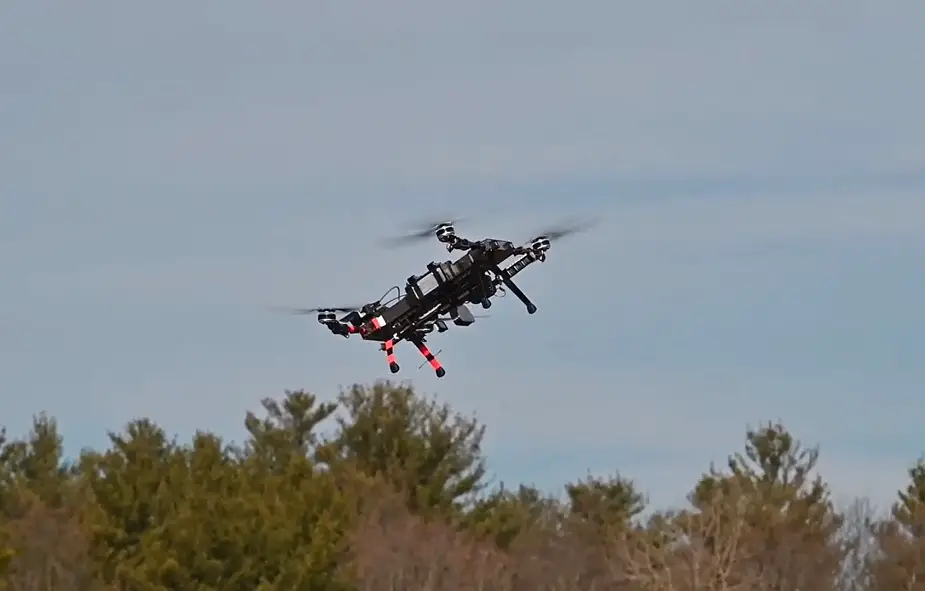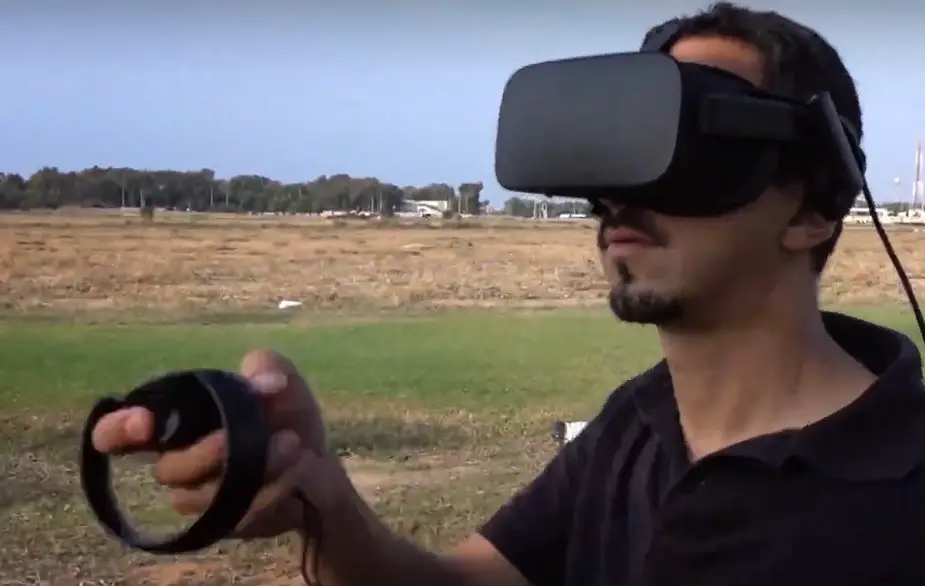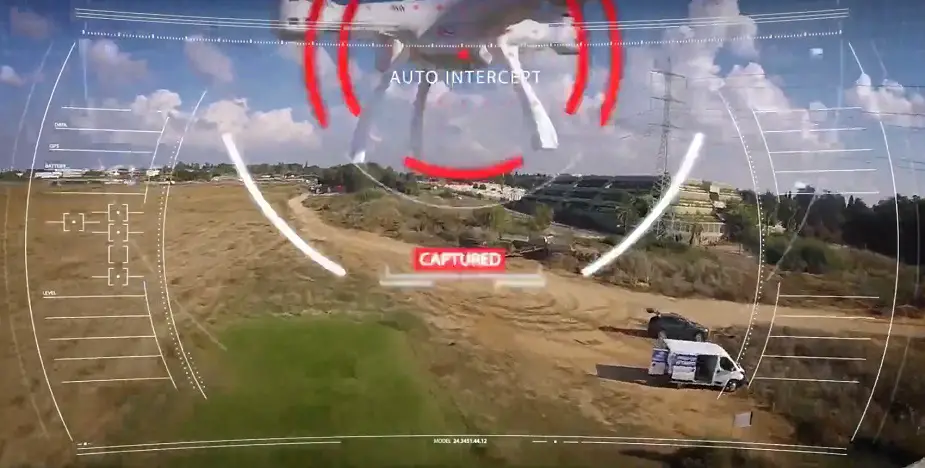Breaking news
Pentagon completes its first counter drone technology demonstration.
Technology developers came together to show their latest in counter drone technology during a demonstration at Yuma Proving Ground, Arizona.
Follow Air Recognition on Google News at this link
 In January, the Joint C-sUAS Office (JCO) and the Army’s Rapid Capabilities and Critical Technologies Office (RCCTO) solicited information from private industry, and received multiple white papers in response.The Skylord Griffon made by XTEND (seen here), the Drone Kill Drone (DKD) by Elta North America, and the Modular Intercept Drone Avionics Set (MIDAS) by Aurora Flight Sciences participated in the demonstration (Picture source: Mark Schauer)
In January, the Joint C-sUAS Office (JCO) and the Army’s Rapid Capabilities and Critical Technologies Office (RCCTO) solicited information from private industry, and received multiple white papers in response.The Skylord Griffon made by XTEND (seen here), the Drone Kill Drone (DKD) by Elta North America, and the Modular Intercept Drone Avionics Set (MIDAS) by Aurora Flight Sciences participated in the demonstration (Picture source: Mark Schauer)
Focused on Low Collateral Effects Interceptors (LCEI), this demonstration is the first in an on-going series of semi-annual demonstrations aimed at evaluating technologies to deliver an enterprise approach to counter growing threats from rapidly increasing small Unmanned Aircraft Systems (sUAS).
In collaboration with the Air Force, the Joint Counter-sUAS Office (JCO) and the Army Rapid Capabilities and Critical Technologies Office (RCCTO) hosted the demonstration April 5-9. Three companies were selected through a Request for Information (RFI) process to attend the demonstration, focused on defeating sUAS in environments that require minimal collateral damage to the surrounding areas or personnel, such as in urban areas.
“This was the first of many industry opportunities as we look to synchronize solutions and counter the small UAS threat,” said LTG L. Neil Thurgood, Director of Hypersonics, Directed Energy, Space and Rapid Acquisition, which includes the RCCTO. “Events like this demonstration at Yuma Proving Ground will help identify new approaches, focus our efforts, and allow us to leverage innovation quickly.”
Following the first demonstration, participants will receive an assessment detailing how their capability performed against certain criteria during the government-funded test. The Air Force will welcome participating systems for further evaluation and possible inclusion in the LCEI development program funded by the JCO starting in FY21.
The systems were evaluated for their effectiveness in defeating lightweight Group 1 UAS. These type of drones are small and quick, hard to mitigate and can carry various payloads, including surveillance equipment.
“This week’s demonstration helps the Department of Defense as we strive to provide the most capable counter-small UAS equipment to our operational forces.” said MG Sean Gainey, Director of the Joint Counter-small UAS Office. “By focusing the first event on low collateral effects interceptors, we are addressing a key challenge when operating in complex urban environments, around sensitive sites, or in situations where the rules of engagement limits kinetic capabilities.”
The three companies – Aurora Flight Sciences, ELTA North America, and XTEND – were invited to the demonstration after they were selected through an RFI released in January 2021. This follows the DoD release of its C-sUAS Strategy, also in January, which provided the framework for addressing sUAS across the spectrum from hazards to threats in the homeland, host nations, and contingency locations.
More than 30 companies responded with three participating in the demonstration. The companies will leave the demonstration with an awareness of their systems’ strengths and limitations against known threats.

According to the company, Aurora’s Modular Intercept Drone Avionics Set (MIDAS) is an artificial intelligence (AI)-enabled, multi-rotor sUAS outfitted with optical sensors and a customized payload that can defeat multiple sUAS per flight with low-collateral effects. An autonomous solution, MIDAS is cued from ground radar and locks on with its onboard sensor.
“Aurora was honored to participate in the JCO and RCCTO demo event for low-collateral interceptors at the U.S. Army Yuma Proving Ground,” said Kel Jackson, Counter-UAS program manager for Aurora Flight Sciences, a Boeing Company. “Demonstrating MIDAS’ differentiated Counter-UAS capabilities in such a challenging environment was invaluable.”
MIDAS is Aurora’s AI-enabled, multi-rotor sUAV outfitted with optical sensors and a customized payload that can defeat multiple small UAVs per flight with low-collateral effects.
- Autonomous from launch through landing
- Cued by radar; optical sensor guides to target
- Precise aiming independent of flight direction
- Low system cost and low cost per kill
- Ground radar interoperability and future proof AI algorithms
Aurora’s multi-rotor sUAV also offers an open architecture for payload integration. Its quick-change modular rails and onboard computer support variable payloads, providing flexibility for evolving threats and alternate use-cases.
The ELTA North America team demonstrated their Drone-Kill-Drone (DKD) system, which they say is 100 percent autonomous from launch to intercept. The system needs no human intervention other than the command to launch. DKD uses a combination of on-board processing, autonomous flight control, and optical target lock to strike the target while in flight. It contains an entanglement net of cut resistant wires that spring-release during flight and entangle rotors for an extremely high kill rate. DKD is modular and scalable to carry additional effector payloads and can be integrated to accept cues from drone detection sensors or Command and Control (C2) systems.
“We all know warfighters are wearing multiple hats as it is, so having something connected to the network that is fully autonomous is crucial,” said Dean Nohe, senior director of business development for ELTA North America. “The DKD takes the network or sensor feed and assigns the right drone to the right threat. Once it gets close to the target, there’s on-board processing and on-board AI that enables an optical target lock and continues the autonomous guidance to the drone until interception.”

 SKYLORD GRIFFON system (Picture source: XTEND)
SKYLORD GRIFFON system (Picture source: XTEND)
XTEND described their SKYLORD GRIFFON system as a C-sUAS platform that allows operators with no flight experience to intercept aerial threats. The system can seamlessly interface with most detection or C2 systems and uses augmented reality to enable the operators to “immerse” themselves in countering sUAS.
“After three days using this system everyone is mission capable,” said Ido Baron, vice president of business development and sales for XTEND. “The system is man portable, lightweight and inexpensive. Each drone is like a bullet in a magazine, with most of the cost in the C2 system and software, which is on the ground.”
According to the company, this technology “fuses edge technology with human-centric cognitive capabilities” allowing operators to deploy multiple drone teams to detect and intercept enemy drones. The SKYLORD GRIFFON provides a “smart” hard kill, which means the CUAS system flies by C2 but once it comes within range of the drone, the operator takes control so they can investigate the target to either intercept it or follow it, providing the full mission spectrum.
Each vendor had similar scenarios and missions as part of the demonstration, which also looked at ease of integration into existing Department of Defense systems, their ability to operate autonomously, and effectiveness at intercepting and targeting hostile UAS.
Future demonstration events will be posted separately as the JCO coordinates with Joint partners to select focus areas providing the most impact to transitioning solutions into production. A second demonstration will occur in late FY21 and an RFI to industry will be released this spring.



















